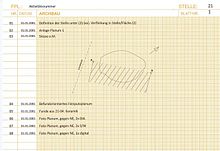Rhenish placement system
The Rheinische Stellensystem is a documentation system for archaeological excavations .
In several German federal states , a system of posts is used to document archaeological findings . For North Rhine-Westphalia this system is prescribed by the respective specialist offices LVR-ABR , RGM and, with restrictions, by LWL- LMfA Münster . The recommendations of the Association of State Archaeologists in Germany also provide for the job system.
The Rhenish site system was developed by the LVR Office for Ground Monument Preservation in the Rhineland (ABR) for field and city core excavations.
Any findings that occur are given a sequential number and are henceforth referred to as position. Each position is assigned an index card with millimeter graduation in DIN A4 format, the so-called position card, on which each work step is recorded in detail according to the specifications of the respective specialist office. A true-to-scale graphic documentation is also made directly on the assigned position card, provided the scale allows this.
In addition to the findings, the entire excavation and individual sections (partial areas) also receive superordinate location maps, so-called area location maps.
If the Rhenish placement system is strictly applied, the excavation diary is also kept on location cards under digit 1 .
One advantage of this documentation system is that when there is a change in the processors, a second person is able to continue processing a finding with the aid of the findings card, seamlessly and without special instruction.
Individual evidence
- ^ LVR Office for Ground Monument Preservation in the Rhineland
- ↑ Roman-Germanic Museum Cologne
- ^ LWL archeology for Westphalia
- ^ Excavation standards of the VLA from April 2006
Web links
- Site of the LVR office for the preservation of monuments
- ABR guidelines (PDF file; 636 kB)

